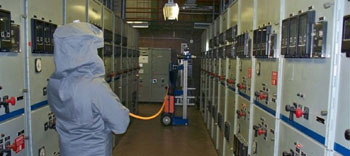Racking circuit breakers is a common task performed by electrical workers. Unfortunately, this task is responsible for numerous serious electric arc flash incidents. The main reason is the moving of parts that must be aligned properly to engage the breaker. Many times these mechanisms are not maintained and cause problems. Over use of force or broken parts tend to cause the issues that lead to arc flash. Another cause is a tool left in the breaker when it is being installed, and thus when energized, a short is caused. The bottom line is movement of energized parts under strain that are not generally properly checked and maintained. Click here to view an arc flash while an employee is racking a circuit breaker.
Listed below are some safe work practices to ensure worker safety when racking circuit breakers:
- Maintain Breakers: As noted above, many arc flashes occur during racking due to improper maintenance. Circuit breakers should be maintained based upon manufacturer guidelines as well as NFPA 70B—Recommended Practice for Electrical Equipment Maintenance.
- Remote Racking Devices: When racking circuit breakers distance is your friend. By doubling your distance from the energy source the new incident energy (calories/cm2) is reduced to approximately one-fourth the energy of the original location. A remote racking device should be utilized whenever feasible. There are at least three (3) manufacturers of remote racking devices:
- CBS Nuclear: A CBS Nuclear remote racking devices is shown in the photo below. Read more here.

- Eaton: Read this Eaton case study
- Powell: Read more here.
- Protective Clothing: Most racking tasks are considered a hazard risk category (HRC) 3 or 4 work task. As a best practice, it is recommended that all power racking activities be considered as HRC4 task with arc rated clothing rated at 40 calories/cm2.
If you have any questions concerning this article or other safety issues, please contact W. Jon Wallace, “The Safety Guru”, at 919.933.5548 or by e-mail

